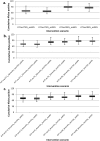Mathematical modelling of the transmission dynamics of contagious bovine pleuropneumonia reveals minimal target profiles for improved vaccines and diagnostic assays
- PMID: 25668725
- PMCID: PMC4323249
- DOI: 10.1371/journal.pone.0116730
Mathematical modelling of the transmission dynamics of contagious bovine pleuropneumonia reveals minimal target profiles for improved vaccines and diagnostic assays
Abstract
Contagious bovine pleuropneumonia (CBPP) is a cattle disease that has hampered the development of the livestock sector in sub-Saharan Africa. Currently, vaccination with a live vaccine strain is its recommended control measure although unofficial antimicrobial use is widely practiced. Here, modelling techniques are used to assess the potential impact of early elimination of infected cattle via accurate diagnosis on CBPP dynamics. A herd-level stochastic epidemiological model explicitly incorporating test sensitivity and specificity is developed. Interventions by annual vaccination, annual testing and elimination and a combination of both are implemented in a stepwise manner and their effectiveness compared by running 1000 simulations per intervention over ten years. The model predicts that among the simulated interventions, the ones likely to eliminate the disease from an isolated herd all involved annual vaccination of more than 75% of the animals with a vaccine that protects for at least 18 months combined with annual testing (and elimination of positive reactors) of 75% of the animals every six months after vaccination. The highest probability of disease elimination was 97.5% and this could occur within a median of 2.3 years. Generally, our model predicts that regular testing and elimination of positive reactors using improved tests will play a significant role in minimizing CBPP burden especially in the current situation where improved vaccines are yet to be developed.
Conflict of interest statement
Figures






References
-
- Thiaucourt F, Van der Lugt JJ, Provost A (2004) Contagious bovine pleuropneumonia In: Coetzer JAW, Tustin RC, editors. Infectious diseases of livestock. 2nd ed. Oxford: Oxford University Press; pp. 2045–2059.
-
- Amanfu W (2009) Contagious bovine pleuropneumonia (lungsickness) in Africa: historical overview: Onderstepoort and veterinary research in Africa. Onderstepoort J Vet Res 76: 13–17. - PubMed
-
- Rich KM, Perry BD (2012) Controlling Animal Disease in Africa Health and Animal Agriculture in Developing Countries: Springer; pp. 305–325.
-
- Masiga W, Domenech J, Windsor R (1996) Manifestation and epidemiology of contagious bovine pleuropneumonia in Africa. Revue scientifique et technique (International Office of Epizootics) 15: 1283–1308. - PubMed
Publication types
MeSH terms
Substances
Grants and funding
LinkOut - more resources
Full Text Sources
Other Literature Sources

